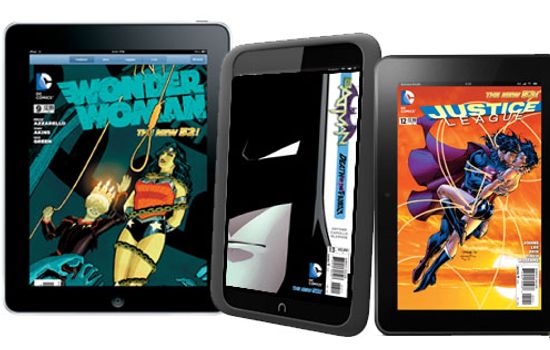While the intellectual properties owned by U.S. comics publishers dominate the movie theaters and toy stores, bringing in billions for their parent companies, the American comic book market has not been operating under a healthy business model for years.
Videos by ComicBook.com
The major comics publishers are publishing most of their product lines now to sales numbers that would have led to cancellation just fifteen or twenty years ago, while the customer base that proudly proclaimed back in the eighties that comics “aren’t just for kids anymore” has only gotten older since. As they pass away, or lose interest in the art form for the last time, they aren’t being replaced in the same numbers by younger readers, who have a wider variety of entertainment opportunities than any generation before them ever imagined.
All of this is compounded by a decision in the 1990s to abandon traditional distribution channels for a specialty market that essentially ghettoized the industry, substantially hobbling its potential for growth by essentially limiting the audience to those already “converted” or those so interested in trying out the product that they’ll seek out these retailers–which are mostly small, operating on a razor-thin margin and so have limited stock on hand.Comics are also a niche market–along with video games, they’re one of the only forms of mainstream entertainment where big chunks of the audience just one day stop engaging. While it’s uncommon for audiences to suddenly and completely give up books, movies or television, it happens relatively frequently in comics, arguably in no small part because the effort it takes to actually find them makes it easy.Driving the market consistently for the last five to ten years has been an ever-escalating series of “event” stories–think big Hollywood tentpole movies, except with limited potential for sequels and a plot that requires you to go see every other movie that studio came out with all summer, or else the plot doesn’t make any sense.As those started to bring back diminishing returns, the major publishers–Warner Brothers-owned DC Entertainment and Disney-owned Marvel–have started incorporating changes to their publishing plans into the event books in a big way. Just over a year ago, DC’s Flashpoint event culminated with the relaunch of their entire publishing line and a reinvention of the shared continuity shared by all of their characters.Dubbed “The New 52,” DC have held their number of ongoing, monthly comics to that number, cancelling underperforming comics and adding new ones in “waves” rather than one at a time in hopes of driving interest in the new product being introduced. That same initiative also saw the introduction of same-day digital releases for all of their serialized superhero comics, handled through ComiXology, a third-party developer who provide web-based and app-based publishing and e-commerce solutions to DC and other publishers.Before DC’s move, only a handful of (mostly small) publishers released product digitally and physically on the same day, and that same small group were the only ones who could be relied upon to add new digital product consistently or on any kind of reasonable schedule. Since DC opened the floodgates, almost every major publisher is now “day-and-date” with ComiXology, excepting Dark Horse Comics (publishers of Hellboy and a slew of licensed products like Star Wars and Buffy the Vampire Slayer), who are also same-day digital but through their own app and website.That aforementioned, aging audience has been extremely resistant to the industry’s move toward increased digital publishing, with many audience members claiming that they will never buy a digital comic book. The publishers, for their part, seem to feel that the potential upside to reaching an entire audience that’s much larger than the number of people shopping int he specialty stores is worth the risk of alienating a small percentage of their existing audience. Getting their product in front of as many eyes as possible–on iTunes and Google Play, for instance–is a way of replacing the newsstands and grocery stores the industry abandoned in the Nineties.At issue is arguably the core question of whether comic books are art/entertainment or collectibles. For years, a part of the comics audience has been “collectors,” people who either read the comics tangentially to buying them or who don’t read them at all, piling up boxes of magazine-format “floppy” comic books either as an end unto itself or in the hopes they’ll appreciate in value like the older material has. There are those who argue that the latter depends on a serious misunderstanding of the modern comics market and the rules of supply and demand, but that’s another conversation. The “collectors” in the market will obviously never switch to digital, and are generally those most resistant to the industry’s push in that direction. The rest of the customer base, the “readers”, are largely less resistant to the change because it doesn’t fundamentally damage what they come to comic books for. There’s certainly a group of readers who have no interest in digital–and of course there are comics specialty retailers and those close to them, who fear the implications of an increasingly-digital future in the same way some Barnes & Noble employees fear ebooks.DC Comics is once again changing the dynamic this week, with an announcement that effective yesterday’s releases (new comic books come on Wednesdays), their weekly shipment of periodicals will be made available on the Apple iBookstore and in the Nook store and Kindle store on the same day as they’ll be in comic shops. This is likely to scare some retailers, as it takes another step out of the process of finding a digital comic (ComiXology, with dozens of publishers using their app and website, can be difficult to navigate).For publishers, though, it’s a brilliant and frankly essential move. Putting single-issue comics in the same digital space as other periodical publications like magazines and newspapers increases the odds that non-readers will find them. Since the birth of the comics “direct market”, visibility has been one of the biggest challenges facing the industry. There’s obviously no lack of interest in Batman and The Avengers, so if those products can be found on the “shelf” next to this week’s Entertainment Weekly, the odds of impulse purchases by casual fans or non-fans goes up substantially.The decision also opens up Barnes & Noble’s Nook to monthly comics for the first time. The very first Nook Color could be tinkered with in order to broaden B&N’s limited app market and support ComiXology, but the retailer removed that “glitch” from the programming for the Nook Tablet and higher. Without ComiXology, collected editions of comic books have been available on the Nook, but those are more price-prohibitive ($9.99 or higher, as opposed to $0.99 and higher for the weekly/monthly periodicals) to curious consumers.American comics have, for some time now, featured some of the most compelling entertainment in the world for a fairly low price point. They tell stories that feature some of the most popular and enduring characters in modern history. The biggest stumbling block to growth for the industry has been access to a larger potential customer base, and digital is slowly but surely fixing that.Whether those of us who have been reading comics for twenty years or more like it or not.









